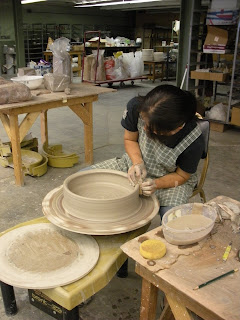
Once centered, the clay was opened up with the palm in a downward motion at the center. 

The clay walls were coned inward and outward several times to get an even wall thickness. Then the walls were pulled to the desired thickness in a cylinder shape.
The rim was a little thicker than the rest of the wall because later as the walls are flattened more horizontal, the rim will thin. Gradually the wall was folded outward starting at the rim and working down the wall until a nice angle was achieved.
When throwing my bowl, it was at this point Hitomi kept telling me to make it wider. The bowl I made was much wider than I would have made without such encouragement. I did not believe that the walls could undergo that much stress until I was forced to do so. Starting at the rim is the key.

This was done until the desired thickness of the floor was achieved, approximately 3/4 to 1 inch thick. The center was widened more and more until the basic shape of the platter was formed, the walls were still very thick but it was opened to the point where the walls would begin. At this point water was added to smooth out the palm impressions.

The clay walls were coned inward and outward several times to get an even wall thickness. Then the walls were pulled to the desired thickness in a cylinder shape.

The rim was a little thicker than the rest of the wall because later as the walls are flattened more horizontal, the rim will thin. Gradually the wall was folded outward starting at the rim and working down the wall until a nice angle was achieved.
When throwing my bowl, it was at this point Hitomi kept telling me to make it wider. The bowl I made was much wider than I would have made without such encouragement. I did not believe that the walls could undergo that much stress until I was forced to do so. Starting at the rim is the key.

.jpg)
No comments:
Post a Comment